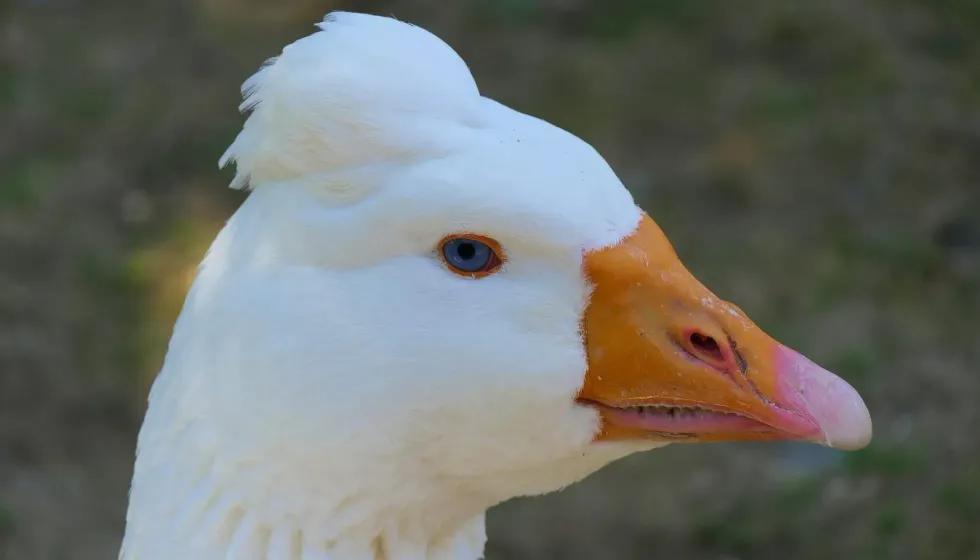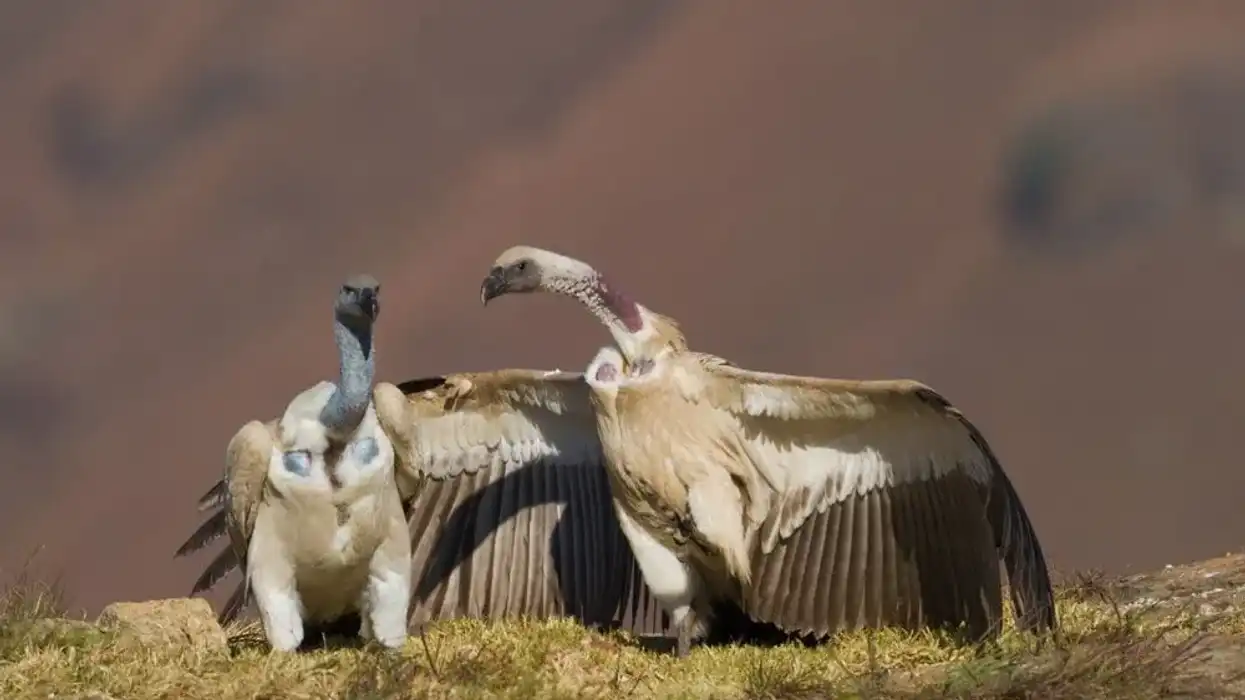There are 16-17 species of goose in the world. Roman tufted geese belong to the same family. Roman tufted geese's scientific name is defined as being from two different genera namely Anser which includes white and grey geese and Branta which includes the black geese. They are closely related to ducks and swans.
Roman tufted geese originated in Italy and are rare in North America, hence they are shown in exhibitions. Roman tufted geese are small to medium-sized and are primarily omnivores.
These species are seen in poultry farms like other species of ducks and chickens and their meat and egg are consumed in certain regions as well. Regions including Europe and Australia where they are consumed as meat and also reared for their eggs.
These birds are known to lay 25-35 eggs per year. For more relatable content, check out these pelican facts and hyacinth macaw facts as well.
Roman Tufted Goose Interesting Facts
What type of animal is a Roman Tufted Goose?
The tufted Roman goose is a goose that belongs to class Aves, the kingdom Animalia, and order Anseriformes.
What class of animal does a Roman Tufted Goose belong to?
The tufted Roman goose is a type of bird species that belongs to the class Aves and the family Anatidae. Tufted Roman goose scientific name is defined as being from two different genera namely Anser which includes white and grey geese and Branta which includes the black geese.
How many Roman Tufted Geese are there in the world?
Roman tufted geese's exact population has not been recorded. Tufted Roman geese are commonly seen in poultry farms where they are raised by breeders.
Where does a Roman Tufted Goose live?
Roman geese live in a poultry farm or in regions near houses as well. Roman geese can be spotted near water bodies as well where they search for prey to feed on. These species are endemic to Italy, Britain and are rarely seen in parts of North America.
What is a Roman Tufted Goose's habitat?
Lakes, lake shores, rivers, and ponds are primarily regions which constitute the habitat of goose species. Tufted Roman geese are alert and have a friendly personality not just to humans but other species of their own kind if a member of their species get injured the other come together to protect the same.
They are also kept on a farm as stock breeds.
Who do Roman Tufted Geese live with?
Roman tufted live by themselves as well as in groups. These species are seldom seen alone and mostly in groups. They reside close to regions where they can find food and shelter easily.
How long does a Roman Tufted Goose live?
The average lifespan of the roman tufted goose is 25 years. A barnacle goose is recorded as being one of the oldest species of Goose that lived for 30 years.
How do they reproduce?
Tufted Roman geese are largely monogamous birds. Roman geese reproduce a single clutch of white eggs from their body in the breeding season which occurs in spring.
Incubating the Tufted roman geese eggs is completely the responsibility of the females while males protect the females from any possible predators. Post this the young gosling becomes independent. The tufted roman geese parents lead the young goslings in a line and alert them about any possible predators.
The moderate egg is taken by breeders to delay further development and consumed just like the leghorn chicken. Consumption of duck or geese eggs is popular in various countries around the world.
What is their conservation status?
The tufted Roman goose is one of the oldest breeds of goose. Its conservation status is not evaluated by the International Union For Conservation Of Nature (IUCN). Tufted roman status critical is in regions like the United States where they are rarely seen.
Roman Tufted Goose Fun Facts
What do Roman Tufted Geese look like?
Goose and ducks are often confused with one another however, ducks and geese are different species of animals. Goose roman tufted has white plumage, blue eyes, and bill is pinkish with a white bean. They have a small compact body, fine-boned plump, and a crest on top of their head.
Some strains have gray or buff feathers. Its paunch has dual lobes. They have reddish-orange webbed feet which help them balance.
Their distinguishing feature is their small tufted feathers on top of their head. Tufted roman top feathers are not a lot in quantity but give these species an overall cute appearance.
It is common to spot a roman tufted goose with some gray feathers in Rome. Their legs are reddish-orange. Their legs are relatively short in height.
Tufted roman males and females appear similar in size with males being slightly larger as compared to females. Their weight is 10-20 lb (4.53-9.07 kg). It's easy to spot them on a farm where they are feeding on an omnivorous diet.

How cute are they?
Tufted Roman geese, with some gray feathers and tuft of feathers on top of their head, are extremely cute, compact and adorable in appearance. Tufted Roman geese are capable of being domesticated and are silent but friendly if approached. They are bred for their meaty carcass.
How do they communicate?
Roman goose is mostly quiet but can tend to be active and noisy in temperament when they are excited for example, when they receive a treat. They are active, alert, and docile.
Docile in the sense they accept control from others. Tufted Roman geese also communicate to other species of their own kind via body language and communication. They express a mourning behaviour when they lose their eggs or partners.
How big is a Roman Tufted Goose?
Roman tufted goose size is 3ft (0.91m) tall which is times bigger than the Indian Runner Duck which is 1.64-2.49 ft. (0.5-0.76 m).
How fast can a Roman Tufted Goose move?
Tufted Roman geese are rarely seen flying and when they do it's at relatively moderate speeds, they are unlike ducks which fly at 40-60 mph.
How much does a Roman Tufted Goose weigh?
Roman tufted goose weigh 10-20 lb (4.53-9.07 kg). Canada goose is considered to be one of the largest and heaviest species of goose weighing about 11 lb (5 g).
What are the male and female names of the species?
A female goose is called a dame and a male is called a gander. Males and females geese differ in reproductive functions. Male geese also tend to be larger in size as compared to females.
What would you call a baby Roman Tufted Goose?
A baby roman tufted goose is called a gosling. Young goslings post the incubation period are completely independent however, they follow their parents until they grow up to a particular age.
What do they eat?
Roman geese's diet is omnivorous in nature and they consume fish, larvae, snail, and crab as well as plant material and seeds. These species of birds are excellent pest control when reared and many people offer them food in tourist destinations native to these species to be around them.
They collectively require a large quantity of food supplies when reared.
Are they poisonous?
No, geese breed are not poisonous in nature and are friendly species. When geese spot treats they are known to create loud noises in order to express their excitement. Geese are fun birds to be around.
Would they make a good pet?
Yes, geese breed will make a good pet but more specifically they are good species of poultry animals when raised on a farm. They have an active personality and have a noisy temperament.
Geese species of birds are excellent pest control as they do feed on pests and hence farmers love to rear them. In many countries, their meat and eggs are consumed similar to other poultry animals.
Did you know...
A group of geese on the water is called a gaggle, and when in the sky they are called a skein.
Media representations of goose breed species include movies like 'Fly Away Home', 'A Birder's Guide to Everything' and other such films which gained popularity and featured different species of goose. Do you remember seeing any goose species in movies?
Geese also have featured their way into ancient history legends like when Geese saved the capital Rome in 365 BC when the geese of Juno warned Romans of the invasion of Gauls. Romans hence consider geese significant.
Gauls planned to invade northern Italy. A statue of a bronze goose is placed in the Capitoline Museum, located in the capital, Rome, however, it resembles a duck than a goose.
Geese always fly in a 'V' formation. When the lead goose gets tired another takes over and the cycle continues until they reach their destination.
The Livestock Conservancy, also known as the American Livestock Breeds Conservancy, is a non-profit organization promoting rare breeds of livestock in the United States.
How did Roman Tufted Geese get their name?
These species are one of the oldest species of geese and are endemic to Rome. They are considered to be sacred to Goddess Juno in Roman mythology in ancient history.
These birds are extremely friendly and originated in Italy. They have a tuft on top of their heads which is a unique distinguishing feature. The tufts set them apart from most other similar species.
How do you identify a Roman Tufted Goose?
If you reside in In North America it is shown in exhibitions and you could visit one if you're interested when they are held to see these exotic beings in North America.
Here at Kidadl, we have carefully created lots of interesting family-friendly animal facts for everyone to discover! Learn more about some other birds including green heron facts and swallow facts.
You can even occupy yourself at home by coloring in one of our free printable roman tufted goose coloring pages.










